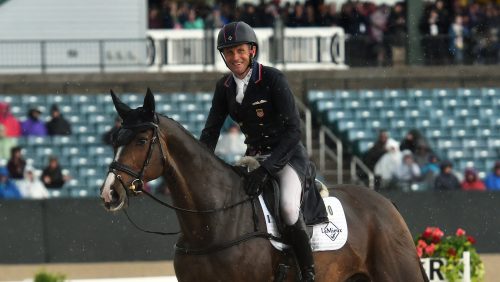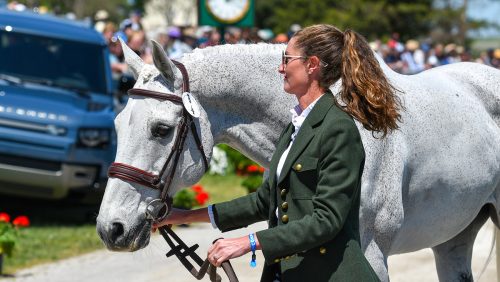For most of his life, Andrew Diemer has been on the back of a horse. Starting as a 3-year-old being ponied by his parents on foxhunts, to joining Pony Club, eventing through the intermediate level and playing polocrosse internationally, horses and horse sports have always served as an anchor for Diemer. Even during the brief periods of his life when he didn’t have a horse of his own, Diemer, 34, always found a way to stay involved.
“You can’t keep me away from the barn for too long,” he said with a laugh. “And I wouldn’t want to be.”
Born with a bicuspid aortic valve—his heart had only two flaps instead of three regulating the outward flow of blood—Diemer was at a higher risk of contracting infections involving the heart. But beyond being prohibited from playing full-contact sports like football, the condition had never slowed Diemer down or prevented him from doing what he wanted to do.
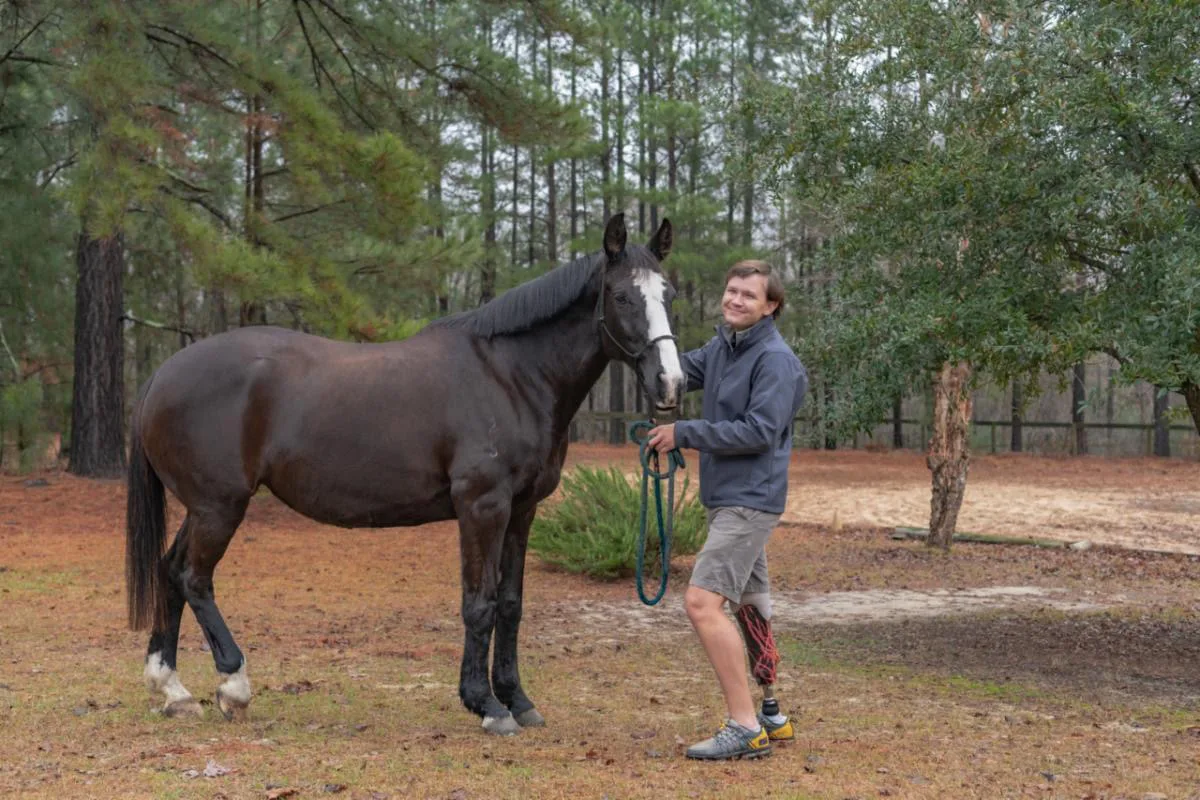
That all changed in 2014, when a series of atypical symptoms culminated in a diagnosis of endocarditis, a rare but life-threatening infection causing inflammation of the heart’s inner lining and valves. In the quest to save his life, Diemer would ultimately undergo a series of open-heart surgeries and lose part of his right leg. But true to his past, Diemer didn’t let even these major health issues keep him out of the tack for long.
Watching Diemer ride today, whether in the jumper ring or on cross-country, you wouldn’t necessarily notice he wears a prosthetic on one leg—except for the time when, according to his mother Dana Diemer, he left the polocrosse field calling for an Allen wrench because “his foot had come loose and turned around.”
Trying Every Sport On Offer
After getting his start foxhunting in New England, Andrew rode with several clubs around the country, as his military family moved regularly; at 6, he earned his junior colors with the South Creek Foxhounds in Tampa Bay, Florida. In 1997, the Diemers settled in North Carolina, where Andrew joined the Moore County Pony Club and began to explore other equestrian disciplines. In what he calls “traditional young boy fashion,” he tried every sport on offer within his first year.
“I developed an affinity for eventing, because, of course, you have the adrenaline of cross-country,” he said. “But largely, for much of my early career, I was sort of your stereotypical young boy. I was pretty good at the jumping, and pretty terrible at the dressage. And as far as Pony Club went, when it came to keeping myself clean—well, my horses were always well tended, but at formals, I was often the kid who had dirt on his breeches.”
Andrew and his father Manny were first exposed to polocrosse through U.S. Pony Clubs; Andrew describes the sport as a cross between polo and “father-son go out back to toss the baseball.”
“What’s great about polocrosse, unlike many other horse sports, is that it is a true team sport,” Andrew said. “Eventing, show jumping or dressage can be team sports, but you are never in there with your teammates at the same time. They are individual sports, where you compile the scores.”
Both Andrew and his father were excited to bring polocrosse back to their local Pony Club—the organization’s first polocrosse rally was held at the Diemers’ leased farm—and they also became some of the first North Carolina-based members of the American Polocrosse Association.
“Polocrosse is still a very small sport in the U.S.,” said Andrew, who noted it is most popular in Texas and Wyoming. “Which means if you show any form of talent, you don’t have as much competition for [international] teams.”
That is perhaps Andrew’s modest way of acknowledging that, by age 16, he was invited to represent the U.S. in international tournaments, making several trips to play in Australia. At 17, he was part of a group of 20 American polocrosse athletes to spend a month training and playing in South Africa. Andrew admits he made it to his C-2 certification in Pony Club expressly to be eligible to represent the organization in a polocrosse exhibition held in the United Kingdom in conjunction with the 2011 World Cup.
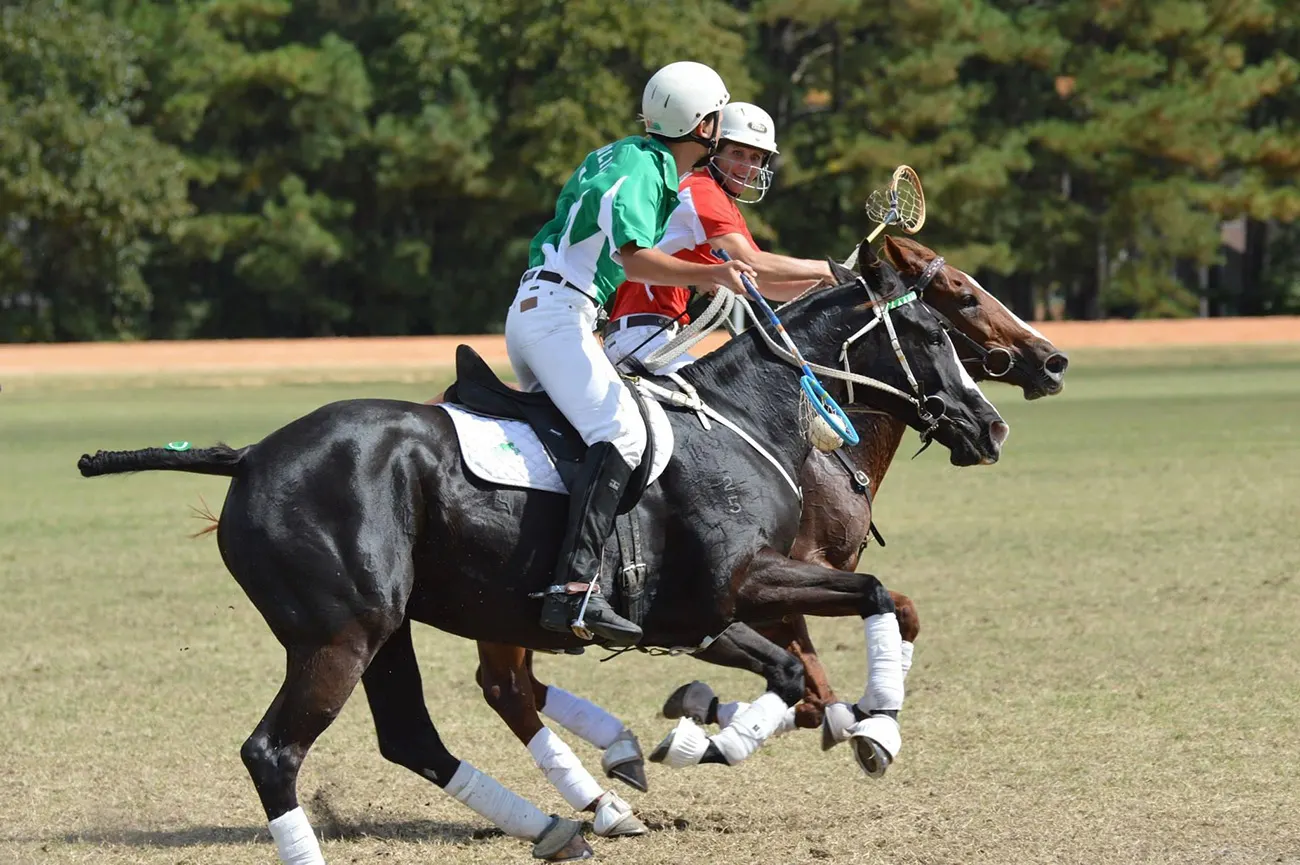
Andrew eventually played polocrosse at the “A” grade level, which he equates to advanced in eventing. In 2013, riding his Australian Stock Horse mare Keystone Silhouette, Andrew was part of the first—and perhaps only—non-Texas-based “A” grade team to ever win an American Polocrosse Association national championship. “Stella” was named best conditioned horse.
“That year, the nationals were held here, in Pinehurst [North Carolina], so it came with all the added emotion of winning on home soil,” Andrew said. “I am very proud of that. But as much as I loved polocrosse, because it is such a small sport, you can’t really be a polocrosse professional. As far as a professional sport, I was going down the road of eventing.”
Andrew had always pursued his eventing goals alongside his polocrosse game, and a Canadian Sport Horse gelding named Cold Harbor eventually brought him to the intermediate level. Under the tutelage of Holly Hudspeth, the pair qualified for the 2008 Young Rider Championships (Colorado) at the two-star level, finishing ninth individually and second in the team competition.
From Joint Pain To Amputation
By 2014, Andrew was 24 and living in Maryland, working an assortment of jobs to make ends meet while riding. When he started experiencing joint pain that fall, Andrew’s doctors assumed he had contracted Lyme disease, because his outdoor-based lifestyle meant he was constantly exposed to ticks. He was put on a course of doxycycline, a powerful broad-spectrum antibiotic known for being effective against the disease’s causative agent.
ADVERTISEMENT
“The doxy seemed to be tamping down the symptoms, but it wasn’t stopping anything,” Andrew recalled. “And then, I started developing a fever on a regular basis.”
This additional symptom, combined with the mediocre response to doxycycline, led to a rheumatoid arthritis diagnosis. He wasn’t convinced; no one in his family had a history with the autoimmune disease, and he had no other symptoms. But he started taking the prescribed immunosuppressant anyway—with disastrous results.
Two weeks later, Andrew woke up coughing so badly he vomited. Soon, he could barely breathe, and his fingernails had turned blue. He texted his then-girlfriend, who left work immediately to take him to the local emergency room.
“When my immune system was already fighting what would later be revealed to be a severe bacterial infection, having my white cells have their legs come out from underneath them was not what needed to happen,” he said. “Pun totally intended.
“By the time I got to the ER, they realized I was going into cardiac arrest,” he continued. “My aortic valve was already rotted away, and my mitral valve was on the way out. The bacteria had been sitting on my heart valves and fighting against my immune system. When the immune system was no longer there because of the medication, it just went haywire.”
Andrew was transferred to the Johns Hopkins Hospital in Baltimore, where he was immediately rushed into surgery. Ultimately, he underwent five open-heart procedures to repair the damage, replace his valves and install a pacemaker. But further complications followed.
“One of the concerns with this kind of infection is if the bacteria doesn’t all come out with the surgery—if it gets into the bloodstream—it can cause clots,” he explained. “That’s what ended up happening to me, in two places.”
The first, and most obvious, clot impeded circulation to Andrew’s right foot; the second was more subtle, affecting his left thumb. With little blood reaching the front half of his foot, Andrew underwent a thrombectomy, in which doctors attempted to remove the clot surgically. When the procedure was unsuccessful, Andrew and his medical team arrived at a difficult crossroads.
“I needed to think about my overall health. I realized I can, as brutal as it sounds, lose a foot. But I couldn’t have any more heart problems.”
Andrew Diemer
“We reached a point where I needed to be a bit more mobile to help my heart get more healthy, and we had to make a decision: Do we wait even longer [for the clot to resolve] and risk having more issues with my heart, or do we go ahead and do the amputation, so I can get into rehab?” Andrew recalled. “In comparison to what was going on in the rest of my body, the foot was cosmetic. I see this in hindsight, but at the time, it made it feel like losing the foot was a side thought.
“It was a huge thing to think about—‘Just chop off my foot, so things will be fine with the rest of me,’ ” he continued. “Obviously, the doctors weren’t putting it across that way. No one was judging me, but a decision had to be made, and soon.”
When it became increasingly clear there was no sign of the clot breaking—unlike the thumb, which had improved on its own—and the health of his foot declined, Andrew began to accept what needed to happen.
“I needed to think about my overall health,” says Andrew. “I realized I can, as brutal as it sounds, lose a foot. But I couldn’t have any more heart problems.”
As Andrew was wheeled into the operating room in February 2015, he didn’t know how extensive his amputation would be.
“The orthopedic surgeon was fantastic, and he had a lot of experience with amputations,” Andrew said. “He was honest with me, that there was a 50-50 chance they would have to take the whole foot, but there was also a chance of saving enough foot to give me a platform to stand on.”
He woke up to learn the amputation began just above the ankle, and his entire foot was gone. But thanks to his surgeon’s skill, Andrew was set up to heal in such a way that adding a prosthetic would be as easy as possible.
“My prosthetic limb has almost always been incredibly comfortable,” says Andrew. “And thanks to the ingenious way he stitched my good, healthy tissue, I was never putting full weight on any of those incisions on the prosthetic.”
In recovery, Diemer defied his doctors’ expectations. His original prognosis involved an initial lengthy in-patient stay, followed by a series of step-down transitions to independent life. But after only one month, Andrew walked out of rehab on his new foot with the aid of a cane. He credits the support of his parents, friends and “great technicians and staff” for his rapid recovery—and the addition of a polocrosse racket to his rehab routine.
ADVERTISEMENT
While in recovery, Sarah Dancsisin, a fellow polocrosse enthusiast who worked for a racket manufacturer, gifted Andrew with a “trick stick.” Where a traditional polocrosse racket is typically too long and awkward to use while unmounted, a trick stick is designed to allow players to work on their ball handling skills out of the saddle.
“I added that into my rehab routine and all the PT I was doing,” Andrew said. “So, if I was doing the balancing ball, I was having the techs throw me the polocrosse ball, and I would toss it to them.
“Because of the relatively small polocrosse community, they all just rallied around me,” he continued. “I got a lot of calls, support and messages. But Sarah in particular, sending me that racket—not only was it super sweet; it affected how the rest of my rehab went.”
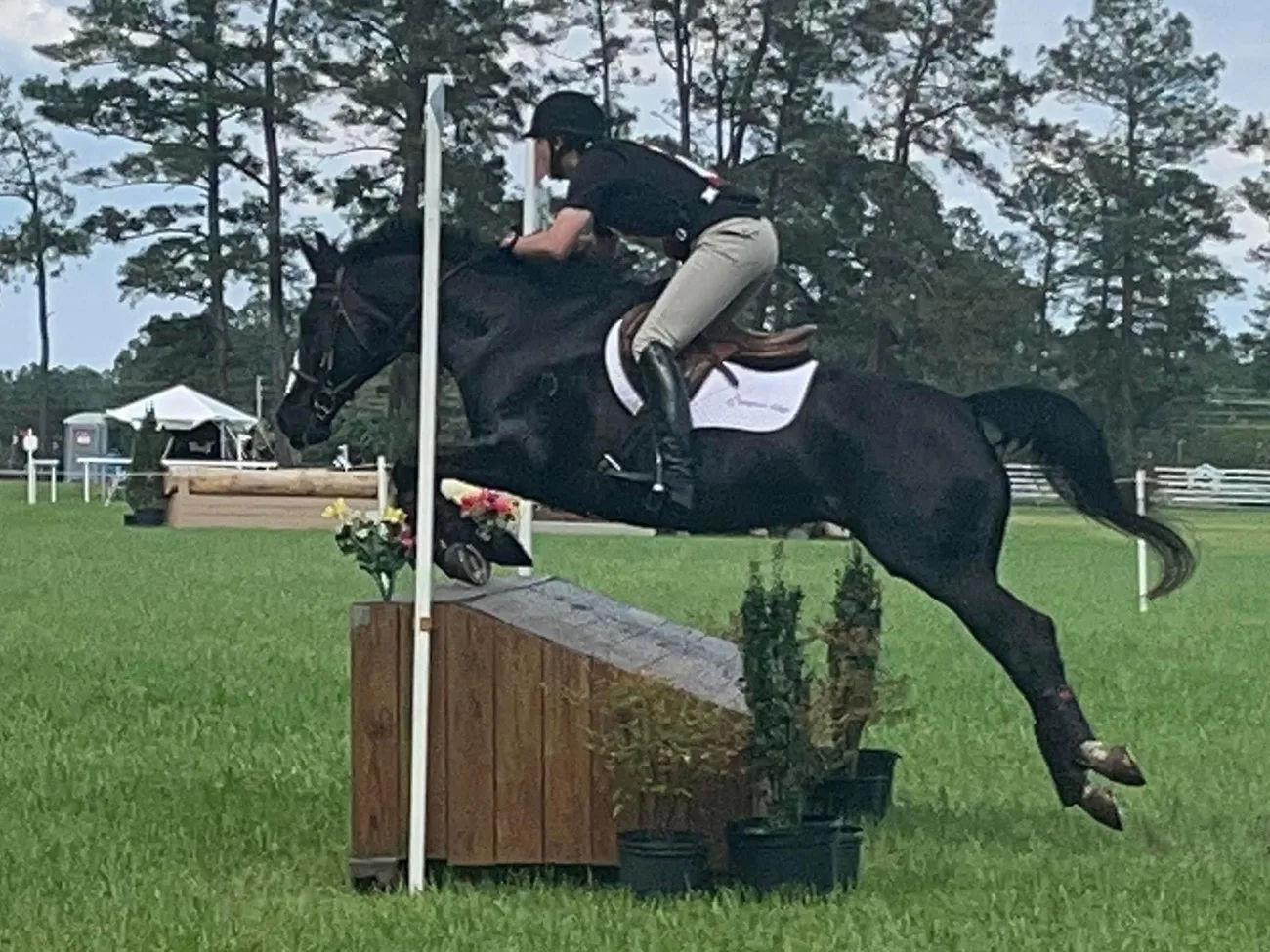
The first stop Andrew made after leaving rehab was the barn.
“Horses were always involved in my rehab,” he said. “My girlfriend had a horse named Dude, the chillest gelding you can imagine, and the first day I was out, she helped me get on him and ponied me around the pasture.”
Andrew admits that learning to ride with his prosthetic—and not being able to feel his right stirrup—did take some adjustment. For a year, he had to remind himself to keep his foot down so it wouldn’t bounce out of the stirrup.
“That was disconcerting for a while, and not feeling balanced in the saddle was incredibly unsettling to me,” he said.
“Ultimately, it gave me new perspective,” he continued. “I can’t remember a time when I was not riding, and while I had to work at certain parts of it—dressage comes to mind—I never had to struggle with the basics. So all of a sudden, at 24, going back and saying ‘How do I post?’ was a struggle.”
He credits lessons with Robin Brueckmann, a USEF “S” judge and para-equestrian, with helping him relearn how to ride.
“What better person to learn from than somebody who has experienced it themselves?” he said. “She was a lot of help to me, especially in those first few years of getting back in the saddle again.”
Andrew eventually felt balanced enough to return to the polocrosse field, though he stepped down a level, playing at the “B” grade in the midfield, a position that typically receives less action. Partnered with Stella, Andrew played on the national championship winning “B” grade polocrosse team in 2016. But after that win, he hung up his racket for good.
“I’m on blood thinners now, and polocrosse is a contact sport,” he said. “I started to realize the bruises I was taking on the field were not going away quite as fast. I was able to go out on a win, and step away from the sport, as far as playing.”
After that, he and Stella focused on eventing, competing to training level. Today, they show primarily in the jumper ring. Andrew also adjusted his career goals; he enrolled at the University of North Carolina at Pembroke, earning first a bachelor’s degree in history, and then a masters in social studies education. For the past three years, he has taught social studies at Southern Lee High School in Sanford, North Carolina.
Last year, Andrew helped his school receive a $10,000 grant to start an Outdoorsman’s Club, with the goal of helping students get outdoors more often. Among the many sponsored activities the club will offer is horseback riding; Andrew has already affiliated with a local riding program to help connect horses with young people who would otherwise never have the opportunity to ride.
“So I’m even bringing horses into the public school system,” Andrew said with a laugh. “I like to share my story with students at the beginning of the school year, just to let them know you can get over this stuff.”






